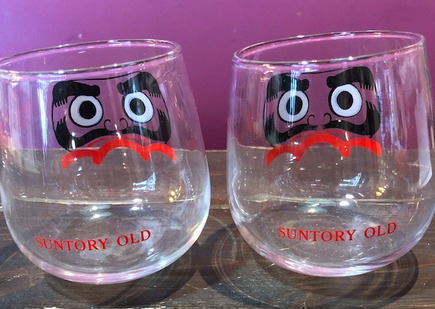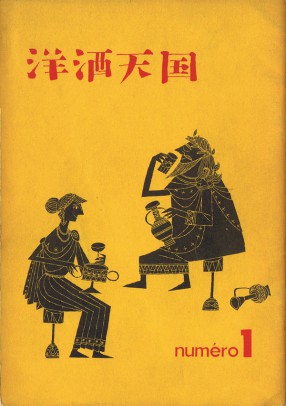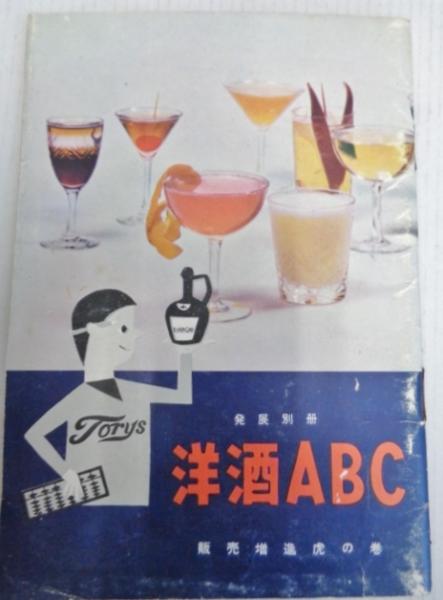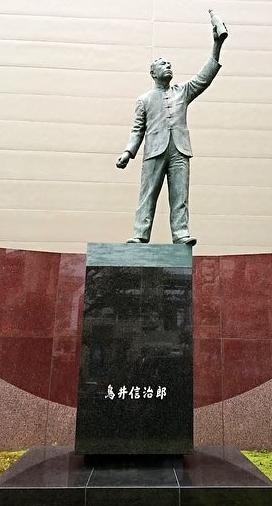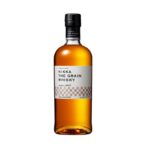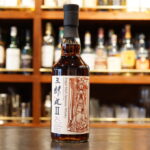1. The division of the world
In 1923(Taisho 12), the postwar depression of World War I still rages.
On January 22, the third son “Michio” is born.
Shinjiro, who wanted to start full-scale whisky production at last, contacted Dr. Moore, an authority on brewing in Scotland at that time, through an introduction from Mitsui & Co. The reply came as a surprise: “There is a skilled engineer in Japan, and he is Japanese.”
The person was “Masataka Taketsuru,” whom Shinjiro had been paying attention to as a skilled brewer of Settsu Shuzo.
1-1 That Man from Campbeltown
After training at Longmorn Distillery in Elgin and Hazelburn Distillery in Campbeltown, Scotland, Masataka Taketsuru entrusted Kiichiro Iwai with the Taketsuru Notebook, and when the time came to build a distillery, the Great Depression would not allow it, and Masataka Taketsuru left the Settsu Shuzo company.
Shinjiro appeared on the scene while teaching science and smoldering his passion for whisky making.
1923 (Taisho 12)
In June, after three rounds of negotiations, Masataka Taketsuru finally joined Kotobukiya with a 10-year employment contract and an annual salary of 4,000 yen (about 10 million yen).
The amount of money shows how much expectation Shinjiro had for him.
In July, the notice system was introduced.
When a large box containing four dozen cases of Akadama Port Wine delivered to a retailer is opened, a postcard is enclosed, and if the retailer writes the name of the store and returns the box, a rebate is sent.
The main purpose of this system is to collect data from retailers and conduct distribution surveys to verify the flow of merchandise.
We also included fountain pens, mechanical pencils, and wallets as gifts for the employees working at the retailers with whom we do business.
The employees ordered the next batch of Akadama and began selling them in a rush to receive their prizes.
In September, the Tokyo office was damaged by the Great Kanto Earthquake.
In October, before the scars from the Great Kanto Earthquake had healed, Shinjiro acquired a site in Yamazaki, Shimamoto-mura, Mishima-gun, Osaka Prefecture, and began construction of Japan’s first whisky distillery, the “Yamazaki Distillery”.
1-2 The Beginning of Japanese Whisky
Rikyu’s Tea House “Waitan
Yamazaki is one of the 100 best water areas in Japan, known as “Minaseno,” which was also used in Manyo poetry. It is said that Sen no Rikyu used this “Rikyu no mizu” to entertain Toyotomi Hideyoshi in his “Taian” tea house.
The Taian is the only existing tea house that has been handed down as proof that Sen no Rikyu actually created the tea house.
The three rivers, Kizu, Katsura, and Uji, converge at the junction of the Osaka Plain and the Kyoto Basin, creating a thick fog, a characteristic that makes the air less dry.
Masataka Taketsuru recommended making whiskey in Yoichi, Hokkaido, but Shinjiro was persuaded by Masataka’s knowledge as a merchant because of the quality of the whiskey, the ease of transporting products, and the proximity to the town, which allowed him to visit the factory.
He asked Dr. Moore to conduct a water quality survey and received his endorsement that the water was soft water with high hardness, which was ideal for whiskey making. Fortunately, there were no orchards nearby, and there were no harmful bacteria that could interfere with the fermentation of the whiskey yeast, so the microflora was good. The miraculous combination of various conditions has allowed Japanese whiskey to take its historic first step here in Yamazaki.
On December 28, an application for a whiskey production license is submitted to the Osaka Tax Supervisory Bureau.
Drying tower at Yamazaki distillery
1924 (Taisho 13)
On April 7, Yamazaki Distillery is granted a license to produce whiskey.
The groundbreaking ceremony for the Yamazaki distillery was held on April 15.
From this time, various products are developed one after another in order to generate funds for whiskey operations, and sales and business are expanded.
In October of the same year, a factory for flavored products is established at the Chikko factory to produce and sell palm curry.
November 11, Yamazaki distillery was completed.
An autumn festival is still held at the adjacent Shiio Shrine to commemorate this day, November 11.
Distilling operations begin in December.
Shrine curtain dedicated to Shiio Shrine by Shinjiro
The selection of the site for the distillery and the construction of the distillery have been very difficult, but another obstacle was the sake tax.
The sake tax at that time was a tax on sake, called zoseki-tax, which was based on the amount of sake produced.
The tax rate was based on the amount of sake produced.
When the stone tax was applied, the tax was immediately levied on the newly distilled sake that was not yet ready for sale.
Seeking understanding for whiskey, Shinjiro repeatedly pleaded with the relevant authorities and won the result of an exit tax.
In December, Kotobuki-ya supervised the manufacturing technology of Nippon Cha Sei Co., Ltd. and launched a lemon tea syrup called “Rechirup”.
1-3 Smoka and Beer
Smoka toothpaste (image courtesy of Smoka official website)
1926 (Taisho 15)
In July, Smoka, a semi-paste toothpaste for smokers, was manufactured and launched.
At a time when powdered toothpaste in paper bags was the mainstream, this high-end toothpaste in a round can made of water attracted much attention.
Toshiro Kataoka’s catchphrase was “Smoka for tobacco drinkers,” and his daily advertisements in small spaces in daily newspapers were successful, and the product became explosively popular.
On December 25, the Taisho Emperor passed away, and the name of the country changed to the Showa era.
1927 (Showa 2)
On September 1, all employees were notified to address President Shinjiro as “master” or “general. (*See Suntory’s company history)
1928 (Showa 3)
On October 17, the Tokyo Branch Office was relocated to 1-68 Kakigaracho, Nihonbashi Ward.
On December 1 of the same year, Suntory acquired the barley brewery of Nichi-Ei Brewery Ltd. which produced Cascade Beer, and turned it into the Yokohama Plant, which began brewing beer the following year.
At this time, Masataka Taketsuru was also assigned as the Yokohama factory manager.
From this year, the beer business continued to struggle throughout Suntory’s long history, and Shinjiro decided to withdraw from the business.
In 1963, Keizo Saji, the second president of Suntory, re-established the business, and after the death of Keizo Saji, Shinichiro Torii and Nobutada Saji continued to pass on the spirit of Suntory from generation to generation.
Established a soy sauce factory in the Yamazaki Distillery and launched Tris Sauce.
1929 (Showa 4)
On April 1, Suntory Whiskey Shirofuda, Japan’s first real whiskey, is launched.
2. The first whisky in our country

山崎ウイスキー館に展示してある白札
The price of “Suntory Whisky White Tag” is 4.50 yen.
The starting salary for a national public servant is about 75 yen, a college graduate 73 yen, and a junior high school graduate 30~35 yen. This shows how much “Shirofuda” was marketed as a high-end product.
The variety used was Golden Melon barley, and the casks used were Spanish Cadiz sherry casks, which are thought to have been used to make red port wine.
The malting was floor malting and the peat was imported from Scotland.
The malt mill and mash tun are said to be Brewers Engineers of Leeds, England, a Porteous licensee.
The pot still is directly fired with coal, and the first and second distillation kettles were made by Tanijin Iron Works and Watanabe Copper Works, respectively.
The huge pot stills, measuring approximately 3.4 m in diameter, 5.1 m in height, and weighing about 2 tons, were transported up the Yodo River on a steamboat, and after unloading, were carried late at night to allow for the passage of trains by laying out koro.
Shinjiro’s first whisky in Japan was made without any compromise in both materials and equipment.
2-1 No Need for Imports
However, it was too far ahead of its time, and customers who drank Shirofuda at the recommendation of Shinjiro and the upper class, who were its main target audience, commented that it smelled burnt and was undrinkable.
The main reasons for this were excessive burning of peat, the beer yeast that was shared from Dai Nippon Breweries, and the fermentation process.
While its smoky flavor might have been well received today, the most significant factor was that the Japanese palate at the time was not yet accustomed to Western culture.
The first first whiskey cask of this white tag is actually still preserved at the Yamazaki distillery today.
It is now known as “Suntory White” and is still loved by many people.
At the same time, “New Cascade Beer” was launched.
On October 24 of the same year, the Great Depression, commonly known as “Dark Thursday,” occurred on Wall Street in the United States.
In an effort to stabilize its own economy, Japan begins to expand its territory in Manchuria.
1930 (Showa 5)
May 1 “Suntory White Tag Pocket Bottle” launched.
On the same day, “Suntory Whiskey Red Tag” (currently Suntory Red) is launched.
A second domestic whiskey with a different blend is released, but again does not do well.
The company also launched “Oraga Beer” following the new Cascade Beer.
The name “Oraga Beer” was derived from a habit of Yoshikazu Tanaka, the 26th Prime Minister of Japan at the time, in which he used the word “Oraga” to mean “I myself” and was very popular at the time.
Tris Curry and Tris Pepper are introduced.
2-2 Yoshitaro joins the company
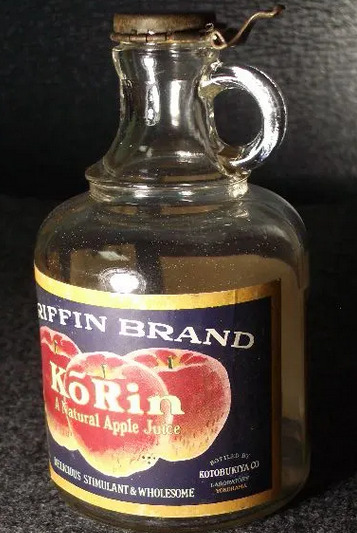
「コーリン」画像引用元:川原の一本松
1931.
On March 1, his eldest son Kichitaro Torii graduates from the Kobe Business College (now Kobe University) and joins Kotobukiya at the age of 22.
In April, the president of the Japanese industrial association “Under the Palace of Fushimi” visited the Yamazaki distillery, and Masataka Taketsuru described the event in “Whisky and I”: “I was also very excited, but at that moment, Mr. Torii was so happy, as if all his hard work had been rewarded”. He added: “I was delighted too.
In August, Kichitaro accompanies Masataka Taketsuru on his third trip to England to succeed Shinjiro.
Outbreak of the Manchurian Incident in September
Cocktails made with Suntory whisky are offered to the public.
The event is considered Japan’s first cocktail competition.
1932 (Showa 7)
Kichitaro Torii is appointed Executive Vice-President on March 15.
On May 1 of the same year, Chiyoda, a synthetic sake, is launched.
On June 1 of the same year, Colin apple juice concentrate is launched.
Rakugo storyteller Tachibanaya Kakitsu is sent to Taiwan to broadcast a three-day advertisement for Akatama port wine on the Taipei Broadcasting Corporation.
This is said to be the first advertising program in Japan (*There are several theories on this subject, and Marubiya is said to have been the first).
On October 1 of the same year, the 10-year-old Suntory Tokkaku, predecessor of today’s Suntory Kaku, was launched.
(*It is also said that Marumiya was the first to do so.) Incidentally, to be clear, as can be found on Wikipedia and other websites, it is also stated that it was the Suntory Ten-Year Whisky Kakubin that was launched, not the Suntory Tokkakuno.
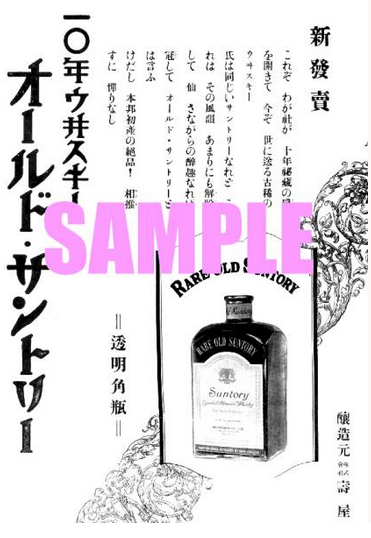
Sur le site internet de la vente aux enchères. Il est indiqué 10 ans de whisky vieux Suntory, et non Tokkaku.
2-3 Kuni leaves and Kataoka leaves.
Despite developing a variety of products and advertising each time, the whiskey business failed to catch on, and the company fell into financial difficulties.
In 1932, Kataoka decided to sell the manufacturing and sales rights to Smoka toothpaste, which was the most promising product at the time.
On October 31, Toshiro Kataoka decided to leave Kotobukiya and transferred to Smoka.
On November 1, the right to manufacture and sell Smoka toothpaste is transferred to Katsutaro Fujino (Kotobuki Meka Co., Ltd.).
It is reported that the previous year, there were no whiskey barrels with a stamp made in 1931.
It seems that the company was in such a state of poverty that it could not even purchase the materials to make whiskey.
1933 (Showa 8)
Branch office opens in Taiwan (2-1 Kyo-machi, Taipei).
August 23, Kuni Torii dies of an acute infectious disease at the age of 46.
Nobuhiro Torii, Executive Vice President and Representative Director of Suntory HD, stated that the annual memorial service for Shinjiro and Kuni is still held at Mount Hiei.
1934 (Showa 9)
On January 12, Suntory begins exporting Suntory whiskey to the U.S., where opposition to Prohibition is growing.
On February 1, the beer business is dismantled and all brewing and marketing rights are transferred to Tokyo Beer Co.
Masataka Taketsuru wrote about his feelings at this time.
The selling price was 3 million yen, which was a very high price for the time and a favorable deal for Kotobukiya. Needless to say, however, it was a shock to me as the factory manager.”
3.Masataka Chiketsuru, to the north
On March 1, in fact, two years had already passed since the expiration of Taketsuru Masataka’s 10-year contract.
He had been asked to take care of his eldest son, Kichitaro, and had been put off, but with the death of Masataka’s mother and his approaching 40 years of age, Masataka decided to leave Kotobukiya.
Masataka Taketsuru then went to Yoichi, Hokkaido, to start Dainippon Juice and then move on to Nikka.
On April 19, the soy sauce factory in the Yamazaki Plant is closed.
On June 21, Kotobuki Budouen (now Iwanohara Budouen) was established through joint investment and joint management with Zenbe Kawakami, the father of Japanese wine.
On October 15, the Domyoji factory (located in Domyoji-mura, Minami-kouchi-gun, Osaka Prefecture, now Fujiidera City) was built and began producing grape wine and fruit juice.
At the same time, the company took over the production of colas from the Yokohama factory.
1935 (Showa 10)
Pompin” cider champagne is launched.
Production and sale of “Hermes Delicatessen Wine (red and white)” and “Hermes Champagne”, fresh grape wine.
Started distilling brandy.
3-1 Prewar cafes and bars enter their heyday

山崎ウイスキー館内に保存してある最初期の角瓶
1936 (Showa 11)
Production and sale of concentrated juices “Tris Grape Juice”, “Tris Orange Juice”, “Hermes Dry Gin”, “Hermes Italian Vermouth” and “Kanrochu” started.
Director Kizo Torii retires from the company on December 28.
Research department develops full-scale liqueur.
1937 (Showa 12)
The predecessor of Suntory Kaku-bottle, which later became a best seller and is still on sale today
Suntory Whiskey Twelve Year Old Kakubin (tortoise-shell shaped), the predecessor of the Suntory Whiskey Twelve Year Old Kakubin still on the market today, was put on sale.
Around this time, cafes and bars began to flourish, and this increased the number of opportunities for Japanese people to obtain imported products, which in turn led to the spread of awareness and popularity of Suntory whiskey.
Suntory, enriched by this influence, increased annual bonuses to its employees, and as a result, there was even an episode in which an employee came to return a portion of his salary, believing that he had been paid one digit in the wrong amount.
July 7: The Roh Tso Bridge Incident Occurs
3-2 Outbreak of Sino-Japanese War
Outbreak of the Second Sino-Japanese War.
The Tripartite Pact of Defense and Co-operation is signed.
Tokyo Brewery releases its second whiskey, “Tommy,” after Suntory.
1938 (Showa 13)
Suntory bar opens in Umeda, Osaka.
Hermes Brandy and Hinomaru Shochu are produced and released.
Ho-Taiko Whisky” with the words “Bu-no Choukyu” (Image credit: Soremosato no Mimi Arukimono)
1939 (Showa 14)
In March, “Toyotaikoh Whiskey” for comfort with amulet of Toyokoku Shrine is put on sale.
In May, Japanese and Soviet forces clash in the Nomonhan Incident.
July 15, National Conscription Ordinance promulgated.
The order authorizes the Minister of Health and Welfare to forcibly recruit personnel in order to secure labor for important industries during wartime.
On August 1, his book “Ikiru Ho-Taiko” (The Living Toyotomi Hideyoshi) was published.
On August 2, he opens a cafe “Tris” in Kitahama, Osaka, to promote Tris tea.
World War II broke out on September 3.
1940 (The 15th year of the Showa era)
On March 1, brewing of grape wine begins in Takehara-cho, Kamo-gun, Hiroshima Prefecture.
3-3 one arm
On September 23, Kichitaro Torii, Executive Vice President, passed away (age 33), reportedly due to myocardial infarction.
Shinjiro said, “One of my arms was ripped off. Japanese medicine is in a bad way.
A few months later, on November 15, former director Kizo Torii died at the age of 72.
Coincidentally, on the same day, the company “announced” the production of “Suntory Whiskey Old.
The reason for this “announcement” rather than “launch” is that whisky is a luxury and luxury item, so it seems that the company was affected by wartime controls and was unable to launch the Old product.
It was the autumn of the 61st year of Shinjiro Torii’s life, a time when he had lost his loved ones and could have lost his whisky at any time due to war.
4.Even in the midst of disappointment.
After the repeated partings with Kuni, Kichitaro, and Kizo, Shinjiro was still determined to help the remaining family members as well as the employees who were like family to him.
1940 (Showa 15)
Begins production of grain whiskey (for old blends) at Osaka factory.
Installed a new brandy distiller at the Domyoji factory and started mass production of brandy.
1941 (Showa 16)
The Japanese Navy launched a surprise attack on Pearl Harbor in Hawaii, leading to the Pacific War.
1942 (Showa 17)
Following the Japanese occupation of Manila, the Japanese occupy Singapore.
4-1 Look up and see the bombers
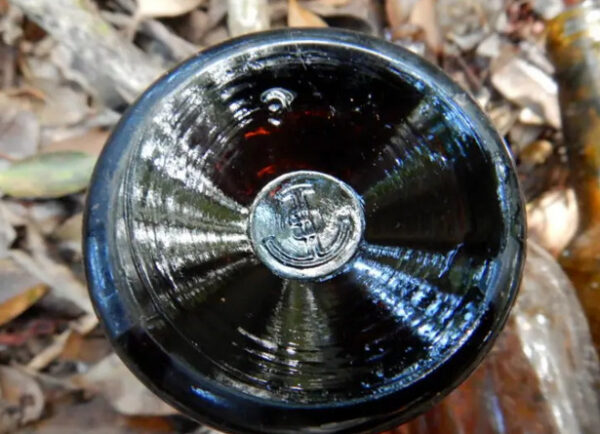
Precious whiskey with the Ikari mark of Hisaya found in the Ogasawara Islands (image source):小笠原陸域専門ガイドマルベリー)
Thirteen U.S. B-25 bombers bombed the Japanese mainland for the first time.
(President: Zennosuke Torii, nephew of Shinjiro) established on November 10 to manufacture and sell curry, pepper and other spices, gold dust, and coffee.
1943 (Showa 18)
On February 1, Japanese forces begin withdrawing from Guadalcanal Island.
June 1, construction of Okinawa factory completed and production of butyl alcohol and ethyl alcohol for aviation fuel begins.
1944 (Showa 19)
On January 4, by order of the Ministry of the Navy, Suntory built a plant in Kumbanjubong, Surabaya, Java, and dispatched employees to manufacture aviation fuel.
On February 25, “Emergency Measures for Decisive Action” was issued.
Cafes, theaters, and bars, which are considered high-class entertainment, are ordered to close for a year.
Instead, publicly operated “national bars” appeared.
At these places, one could buy a ticket at the entrance and be served a single beer or a bottle of sake, but even a single beer or a single bottle of sake would draw a long line, and there were constant interruptions and fights.
On April 11, by order of the military, the company acquired land adjacent to the Osaka Plant and built Osaka Plant No. 2. It began manufacturing aviation fuel.
4-2 Designated as Osaka factory munitions company
On April 25, the company is designated as a munitions company by the Minister of the Navy, and the Osaka Plant becomes its designated factory.
On June 30, an order was issued to evacuate large cities. School children are also evacuated en masse.
On July 2, the Japanese forces on Saipan Island are annihilated.
November 24: Tokyo’s first major air raid
1945 (Showa 20)
On March 1, all Japanese forces are destroyed on Iwo Jima.
On March 13, an air raid burns down the head office building in Sumiyoshi-cho, Higashi-ku, and opens a temporary sales office in Dojima-Nakadori 1-chome, Kita-ku, Tokyo. On June 1, an air raid damages the Osaka Plant and Osaka Plant 2, destroying most of the plant.
On August 6, the atomic bombing of Hiroshima was followed by the atomic bombing of Nagasaki on August 9.
On August 15, Japan accepts the Potsdam Declaration and unconditionally surrenders, ending the Pacific War.
4-3 end of war

米軍GI用ウイスキー「ブルーリボン」画像引用元:ジャパニーズウイスキーデータベースwiki
Later, GHQ, an Allied military agency, was established in Japan to enforce the Potsdam Declaration.
The first thing GHQ did was to seize all war materials.
Osaka was about a week behind Tokyo, but many items were seized in Tokyo.
Among them were whiskey barrels, and everything that contained alcohol was seized.
This information reached Shinjiro in Osaka.
Shinjiro was concerned about the seizure and tried to hide it.
However, he thought that there might be another way rather than hiding it, so he decided to approach the Occupation Forces and deliver the whiskey to them.
On October 1, General Headquarters of the Occupation Forces ordered Suntory Whiskey and deliveries.
Accordingly, “Blue Ribbon” whiskey for U.S. GI’s was released.
October 9, headquarters moved to 2-2-1 Dojimahamadori, Kita-ku, Tokyo after the disaster, and the temporary sales office was abolished.
November 1, whisky for U.S. military officers, “Rare Old” is released.
Despite the postwar period, Shinjiro continues to ride the wave of the times without fear of failure, despite his seven failures, in order to protect Yamazaki’s original sake, and eventually becomes the whisky of choice at GHQ.
5.The second generation who was called “Henkotsu
信A number of employees saw Keizo Saji run out of the president’s office, where Jiro was standing, with an angry shout echoing through the room.
He is a henkotsu,” Shinjiro told his third son Michio Torii.
The word “hekkotsu” is an Osaka dialect word meaning “eccentric,” “spirited,” “rebellious,” or “twisted.” Shinjiro himself is a hekkotsu, and the way he puts himself on the shelf is an episode that reminds us of a father and son relationship.
On February 1, 1946, Keizo Saji, who would later change the company name from Kotobukiya to the current name Suntory, and who would achieve the feat of taking Suntory to the top of the beer industry, which Shinjiro had given up on, and would have a great influence on the development of Japanese entertainment and art, including the construction of Suntory Hall and the Suntory Art Museum, joined Suntory.
5-1 Keizo Saji
Keizo Saji was born on November 1, 1919 as the second son of the Torii family.
He entered an unusual kindergarten called “Ienashi Kindergarten” near the residence in Hibarigaoka.
The kindergarten was characterized by its educational policy of providing care outside in parks, riverbanks, and satoyama, without having a school building.
After graduation, he attended elementary school at the Prefectural Normal Elementary School in Ikeda, located at the northern tip of Osaka Prefecture, a five-minute train ride away.
In 1932, he entered Naniwa High School, but due to his weak constitution, he developed pulmonary infiltration and was forced to stay in school.
When he was in elementary school, he was offered for adoption and changed his family name to Saji.
Keizo recalls this time as follows.
It was during spring break at the end of my sixth grade year in elementary school that I encountered a truly significant turning point in my life. I was adopted.
My parents must have known this long ago, but for me, it came as a bolt out of the blue. I had been living under my parents’ name, Torii, without any inconvenience until now, and tomorrow my family name would change to someone else’s. I knew what was going to happen, but I was not prepared for it.
I did not really know what the change would be, but I just felt sad and clung to my mother’s lap with a feeling of helplessness.
I think it was around this time that I made the trip to Misasa Onsen.
However, there are many inconsistencies, such as the fact that he did not move to his adopted family’s house and continued to live with his family, and that his mother’s family name is Ozaki.
In his blog, “The Mystery of Keizo Saji’s Adoption and Surname Change,” Masuo Nagasaka has written a very interesting article.
It may have something to do with the fact that the Yamazaki distillery ran out of operating capital in 1931, the very year that the distillery stopped all operations.
After graduating from Naniwa High School with a Bachelor of Science degree, he entered the Department of Chemistry at Osaka Imperial University in 1940 on his father’s advice.
Upon graduation in 1942, he enlisted in the Navy and joined Kotobukiya after the war.
5-2 Rampant black market
March: Rampant black-market liquor and a series of methyl fatalities
Numerous drinking establishments lined the streets of the so-called “black market” serving moonshine called “bakudan,” which is made by diluting fuel alcohol with water, and “kastori,” which is made by fermenting cheap sweet potatoes, barley, and other sugars.
Bakudan” contained methyl alcohol, which caused a number of deaths and blindness, while “kasturi” was said to be free from poisoning, although it had a nasal odor. It seems that the Yurakucho area, where newspaper companies and publishers gathered, was lined with kastori stalls where writers, reporters, and editors who loved to drink gathered.
On April 1, part of the damaged Osaka factory was reconstructed, distilling operations resumed, and at the same time, the Izumiotsu factory was opened in Izumiotsu City as a factory specializing in barrel making.
Tris Whiskey was also re-launched after the war.
The Constitution of Japan is promulgated on November 3.
1947 (Showa 22)
Keizo Saji is appointed director on January 30.
Company song adopted in April.
As a side note, the first company song in Japan is said to be “Manchurian Railroad Song” written by the Manchurian Railway Company in 1917.
This was followed by the first company song boom from the late 1920s through the 1930s.
The domestic company songs that emerged during this period had a strong image of a military song due to the prewar and wartime period.
In the 1930s, companies that still represent Japan today, such as Kajima Corporation and Matsushita Electric Works, established their own company songs, but Kotobukiya was a little late in adopting one.
Unfortunately, Suntory’s public relations department could not tell us the full lyrics of the song, but we found out the following
The first part of the lyrics is about Akadama sweet wine, the fifth verse, which was added in 1950, seems to include Tris (Tris whiskey) in the lyrics, and the sixth verse, which is about the company’s new beer, was added in 1966.
And in 2002, number 7 was added with the corporate philosophy in the lyrics.
Suntory’s new employees are having a hard time remembering the lyrics.
July, Akatama Seikyu Budoshu is launched.
August 1, “Hermes Peppermint” was launched.
1948 (Showa 23)
On September 1, “Suntory Yeast” for bread making was produced and released at the Yamazaki factory.
5-3 Later Honorary Chairman Michio Torii
1949 (Showa 24)
Michio Torii, the third son, joins the company on July 21.
October 16, the first postwar newspaper advertisement is placed and the catchphrase “good and easy” is used for Tris whiskey.
November 11, Director Keizo Saji becomes Senior Managing Director.
Hermes Orange Curacao” produced and launched.
1950 (Showa 25)
One-page gravure newspaper advertisement for Tris Whiskey is placed on January 1.
On March 1, production of Tris whisky is moved to the Osaka factory to increase production. Mass sales begin around this time.
April 1, Western liquor price controls are abolished. The company is able to set its own sales prices.
August: “Suntory Whiskey White Tag Baby” produced and released (the first baby bottle).
Daikoku Budoshu’s “Ocean Whiskey” enters the Kansai market.
Demand for third-class whiskey begins to grow.
10 years after its announcement, “Suntory Old” is launched.
6.It doesn’t just happen, Daruma.
Old, which had not been allowed to be sold due to the influence of wartime, was released in full force.
Thanks to the influence of third-class whiskies, lower-priced whiskies became more affordable, and whiskies became more accessible than before, sales of Suntory Old gradually increased, and by 1980 (Showa 55), more than 130 million bottles had been shipped.
It was exported overseas and became so popular that it accounted for half of Suntory’s sales in that year, becoming one of Suntory’s most popular products.
6-1 old shock
Despite strong sales, the following year, 1981, the Consumer Federation conducted an investigation into the ingredients of Suntory Old, resulting in what is known as “Old Shock”.
Ingredients such as 27.6% malt whiskey, 45.1% glen whiskey, 26.1% pumped water, 0.8% sweet fruit wine, 0.4% liqueur, and 0.6% caramel were detected.
The Consumer Federation’s opinion pointed out and judged that the product may have been made by adding grain alcohol to a small amount of unaged base alcohol and adjusting the taste and color by using caramel and liqueur.
Suntory’s response was that “Glen whiskey,” which is 45.1% of Old’s ingredients, is not “grain,” meaning grain, but “glen,” meaning valley, after the name of the place where it was produced, Yamazaki Gorge, but the truth is not clear.
One of the reasons may be that at that time, it was not necessary to apply for the age of the casks in order to use the special class designation.
The bottle is now made from Yamazaki distillery’s original sake and is nicknamed Daruma, Tanuki, or Kuromaru, and is often drunk as a good-luck charm because, along with Old Par, the shape of the bottle prevents it from falling over.
Even today, Suntory Older is sold with a label printed with the Chinese zodiac sign of the year every year.
1951 (Showa 26)
January 1, Izumiotsu factory is closed and the barrel-making factory is moved to the Osaka factory.
March: Tokyo Brewery “Tommy Malt Whiskey White Label” released.
April 1, “Suntory Soda” produced and released.
June 1, “Delks Tris Whiskey” for gift giving is produced and released (the first Delks bottle).
Prime Minister Shigeru Yoshida visits the Yamazaki factory on June 15.
In the same month, “Hermes White Curacao” is produced and released.
On November 26, Michio Torii, the third son, is appointed director.
In the same year, sales of sweetened grape wine returned to prewar levels, with Akatama leading, followed by Bee, Daikoku, and Kokoku.
1952 (Showa 27)
April: “Cherry Brandy” produced and released.
June 11, Sapporo Branch Office opened in Minami Ichijo Nishi 5-chome, Sapporo.
Around this time, Dainippon Fruit Juice Co., Ltd. changes its name to Nikka Whiskey Co.
Production and sales of “Trisconk Juice”, a juice to be diluted like Calpis, resumes.
6-2 Third class whiskey thriving
In this year, the third-class whiskey industry became a central force, and competition intensified with Nikka, Ideal, Tommy, Alp, Silver Fox, Ocean, etc., following Tris.
1953 (Showa 28)
On February 20, the Kotobukiya Shoho “Kaihatsu” (Development), which had been suspended during the war, was reprinted.
On March 1, on the occasion of Crown Prince Akihito’s visit to the U.K., the company receives an order for Suntory Prince Whiskey.
On the same day, the New Sake Tax Law was enacted, dividing sake into nine categories: sake, synthetic sake, muddy sake, shochu, mirin, white sake, beer, fruit wine, and miscellaneous liquors, with miscellaneous liquors (Western-style liquors) divided into three classes: special class, first class, and second class.
Whiskey with an alcohol content of 43% or more by volume and a whiskey content of 30% is classified as “Tokkyu”, whiskey with an alcohol content of 40% or more by volume and a whiskey content of 5% or more is classified as “I-kyu”, and whiskey with neither Tokkyu nor I-kyu is classified as “II-kyu”.
April: Begins advertising Tris whiskey as “hot in winter” and “highball in summer” as the preferred way to drink Tris whiskey.
June 1, Nagoya Branch Office opens in Kakuozan-dori 3-chome, Chikusa-ku, Nagoya.
On October 10, a new national anthem, “We Love You,” is released, with Keizo Saji playing a central role in soliciting public participation.
A national anthem is different from a national anthem, but is intended to be widely recognized and sung by the people.
For example, “Eikoukan wa Kimi ni Shine,” widely known as the theme song of the Koshien (Koshien) baseball tournament, and the radio exercise song, “A new morning has come, it’s a morning of hope.
1954 (Showa 29)
On January 29, Kozo Sakuta, Senichi Hirai, Hisakichi Honda, and Michio Torii were appointed managing directors, and Ul Shirae, Takeo Shibano, and Setsuro Matsumiya were appointed directors.
On March 1, the barrel-making division of the Osaka factory was relocated to Oaza Yamazaki, Oyamazaki-mura, Otokuni-gun, Kyoto Prefecture, and renamed the Yamazaki Barrel Making Factory.
On September 15, Suntory Yeast Sales Ltd. is established and entrusted with the rights to sell yeast.
Production and sale of “Akadama White Wine” commenced.
1955 (1955)
On March 1, Akadama White Wine was exported to the U.S. for the first time as “Akadama Red Light Wine”.
*** Translated with www.DeepL.com/Translator (free version) ***
7.The highest honor and the last whiskey.
Shinjiro’s actions are finally rewarded, as he continues to follow his mother’s childhood teaching of “ontoku,” which means “let bygones be bygones, but let the favors you receive be engraved in stone.
Shinjiro’s actions were finally rewarded as he continued to follow his mother’s childhood teachings of “ontoku,” or “virtue in the form of a shadow.
On March 28, Shinjiro Torii was awarded the Medal with Blue Ribbon for his service to the sake industry.
On June 21, the company acquires the factory of Tokyo Jozo K.K. in Oaza-Fujisawa, Fujisawa City, and begins renovations to transform it into the company’s Fujisawa factory.
On September 1, “95 Proof Hermes Dry Gin” was produced and released (renamed “Suntory Gin 95 Proof” in April 1966).
November 12, holds the first Mukai Shiyo-ki championship baseball tournament for baseball teams from distributors nationwide.
In the same month, sent a pamphlet “Twelve Chapters on Domestic Whiskey” to all liquor stores, appealing for greater awareness of classifications, capacities, and prices, and pointing out the business practices of other companies that mislead consumers.
This appeal and the promotion of Tris led to the gradual unification of domestic second-grade whiskey to the round bottle standard of 640 cc for 340 yen.
In the same month, a barrel-shaped advertising car and a chonmage car with model bottles of Tris and Akatama on top were developed and put into operation as sales promotion vehicles.
Around this time, Tris bars and Suntory bars were opened one after another, mainly in Tokyo and Osaka.
Installed super-aros-pass distillers at Osaka and Usuki factories.
Around this time, Daikoku Budoshu builds the Karuizawa malt whiskey distillery.
7-1 Reading Heaven
1956 (Showa 31)
The first issue of Yosake Tengoku, a PR magazine for chain bars, is published on April 10.
Edited by Ken Kaiko, Hitomi Yamaguchi, and others, and illustrated by Ryohei Yanagihara, this was Kotobukiya’s PR magazine.
It is also known as the “Iwanami Bunko (Iwanami Library) of the night.
On August 1, “Hermes Vodka” is manufactured and released.
On September 17, the first “Kotobukiya Management Course” is held in Osaka City to promote management of liquor stores and knowledge of Western liquor.
Increased capital to 192 million yen on September 21.
Launches “High Ball Set” and “Gin Fizz Set” (details unknown from company history only).
1957 (Showa 32)
June: President Torii appointed director of New Toyo Glass Co.
On July 1, a PR color movie “No Story of Grape Wine” was produced, showing the grape cultivation and grape wine production process at the Yamanashi farm, and was shown in movie theaters in various cities.
On July 10, acquired a 10,000 tsubo (approximately 1,000 square meters) site in 59 Imaiue-cho, Kawasaki City for the construction of the Tamagawa Plant, and immediately began the first phase of construction.
August 15, published “Western Sake ABC” (a sales promotion guidebook) and distributed to sake retailers throughout Japan.
December: “Hermes Creme de Cacao” was produced and launched.
1958 (1958)
February 7, the first phase of expansion of the Yamazaki factory (preparation, fermentation, and distillation facilities) is completed, bringing the total number of pot stills to four.
March 20: “Tris Fresh Juice in a Can” manufactured and released.
March 25, “Suntory Ginger Ale” produced and released.
July: Rum production facility completed at Usuki Factory.
October 20, “Hermes Delicatessen Wine” produced and released.
November 25, “Hermes Sloe Gin” and “Hermes Violet” are produced and released.
December 4, “Hermes Baby Cocktail Set” was produced and released to promote home bars.
December: “Akadama Port Wine Baby (Cassie)” was produced and released *”Cassie” is the nickname for a small bottle of Akadama.
1959 (Showa 34)
March 12, construction of a new malting plant using the Van der Haugen method completed at the Yamazaki Plant.
May 11, construction of the second phase of the Tamagawa Plant (liqueur factory) completed and work begins.
On November 28, “Rawhide,” a western movie, was broadcast every Saturday night by the Company.
December 28, Fujisawa factory was transferred to Morinaga Brewery Co.
1960 (Showa 35)
March 7, “Hermes Table Wine” was produced and released.
March 11, construction of a new four-story steel and reinforced concrete warehouse at the Yamazaki factory was completed.
Opened “Ginza Suntory Cocktail School” in Ginza, Tokyo on April 1.
May 19, held a ceremony to commemorate the 60th anniversary of the founding of Kotobukiya.
June 24, “Hermes Green Tea” was launched.
Hermes Creme de Mocha was launched on July 20.
7-2 Posthumous work, Royal
On August 2, as a commemorative product for the 60th anniversary of the founding of Kotobukiya, the company produced and released Suntory Royal, a top-quality whiskey, a high-end version of Suntory Old.
The bottle design was conceived by Shinjiro himself, and the body was designed to resemble a rooster, which is the part of the kanji character for “sake.” The “rooster” also means “bird,” the tenth of the twelve signs of the Chinese zodiac, and also has the meaning of a drinking vessel.
The cap has a gentle curve and is said to be inspired by the torii gate of the Shiio Shrine located behind the Yamazaki distillery.
The taste and aroma are inspired by the cherry blossom snowstorm that hangs over the torii gate on the approach to the Shiio Shrine, and the combination of Shinjiro’s inspiration, taste, and market research, which is Shinjiro’s greatest strength.
Shinjiro Torii’s inspiration, his sense of taste, and his market research, which is his greatest strength, are embodied in the “Golden Ratio,” and this “Suntory Royal” is the last whiskey of Shinjiro Torii.
On August 10, began production and sales of canned highball “Tris Wistan”.
On August 22, an alliance was formed with Royal Crown Cola Company of the U.S. for the sale of bottled Royal Crown Cola and other beverages of choice.
December 20, “Yosake Tengoku”, a book written by Managing Director Saji and published by Bungei Shunju, a book about exploring the world of sake.
1961 (Showa 36)
Capital increased to 2 billion yen on January 30.
February 25, “Akadama Port Wine Tokutei Bottle” was produced and put on sale.
April 22, “Royal Crown Cola” bottled and released (first use of route sales)
May 30, Shinjiro Torii appointed Chairman, Keizo Saji appointed President, Michio Torii and Saburo Hara appointed Senior Managing Directors.
September 11, “Drink Tris and Go to Hawaii” consumer special sale implemented.
October 9, Suntory Whiskey becomes the first Japanese whiskey to receive label registration approval in the U.S.
Also, signs U.S. sole distributor agreement with Lewis Foreman.
November 20, Suntory Museum of Art opening ceremony held.
Established Kanto Malt (now Suntory Malting) in Nakaokamoto, Kawachi-mura, Kawachi-gun, Tochigi Prefecture, on December 8.
In December, the radio program “Music for a Million People”, which had been broadcast by Suntory for 10 years, ended after 520 broadcasts.
1962 (Showa 37)
Chairman Shinjiro Torii passed away on February 20 (at the age of 83) and was awarded the Order of the Rising Sun, Gold Rays with Neck Ribbon, Fifth Class.
Try it and thanks to you.
Under the strong influence of his mother, Shinjiro has been taught that “if you do good deeds in secret, you will eventually be rewarded in a way that you can understand” (yin de koku wa yo-ho aru).
While doing business, she never lacked faith and never asked for anything in return from those she gave to, sometimes providing various forms of assistance anonymously.
In 1921, he established the “Imamiya Clinic,” which provided free medical care and medicines in the Airen area of Imamiya, Osaka City, and a social welfare organization called the “Kunijukai” was founded.
The name “Kunijukai” is a combination of the name of Shinjiro’s wife, Kuni (Kuni), and the store name of Kotobukiya.
In addition to the clinic, during the chaotic postwar period, the organization also established the “Komagawa Home” for war victims and repatriates, and the “Akagawa Home” for those who had no relatives, providing lodging for those who had nowhere else to go due to the war.
After the postwar turmoil subsided, both homes contributed to the development of the community as nursing homes and daycare centers for the elderly.
Shinjiro, who followed the “three-fold profit principle,” never forgetting his religious beliefs and serving others more than anyone else, was one of the greatest figures in Osaka during the Meiji, Taisho, and Showa eras.
One year after Shinjiro’s death, Keizo Saji, who had already inherited most of the business for several years, changed the name from “Kotobukiya
On March 1, 1963, the company moved forward under its current name, Suntory Limited.
In his column “My Resume,” which appeared in the Nihon Keizai Shimbun in later years, Keizo Saji wrote
In his column “My Resume,” Keizo Saji wrote, “My father, Shinjiro Torii, was a man who rarely stayed at home and could hardly be called a family man,” and Masataka Taketsuru wrote, “It goes without saying that my whiskey life would not be possible without Mr. Torii.
In 1981, when a bronze statue of Shinjiro Torii was completed in Chikko Suntory’s Western-style sake plant in Osaka, Konosuke Matsushita, despite his 87-year old age, is said to have participated in the ceremony and delivered a speech at the unveiling ceremony.
The bronze statue of Shinjiro holding a bottle of Akadama port wine in front of the main gate of the Osaka factory, which was completed at that time, has his left leg protruding from the pedestal.
This is a symbolic representation of the spirit of “Give it a try, and you will be rewarded.
Although he went through turbulent times, sometimes shed tears when parting with loved ones, and faced opposition and criticism from those around him for his decisions, the teachings of the great man, Shinjiro Torii, who devoted himself to introducing whiskey culture to Japan, “Give it your all” and “Thanks to you” have been passed down from generation to generation, even today as a world-class top company. The teachings of the great man Shinjiro Torii, who was a world-class businessman, are still alive and well.
In his later years after retirement, Shinjiro was said to be a man who was always fond of his grandchildren, and he sometimes visited the Hibarigaoka Kindergarten next door to his home to watch the children playing peacefully.
*** Translated with www.DeepL.com/Translator (free version) ***

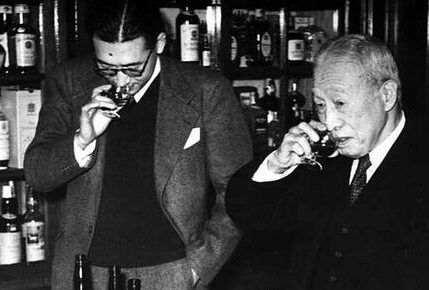
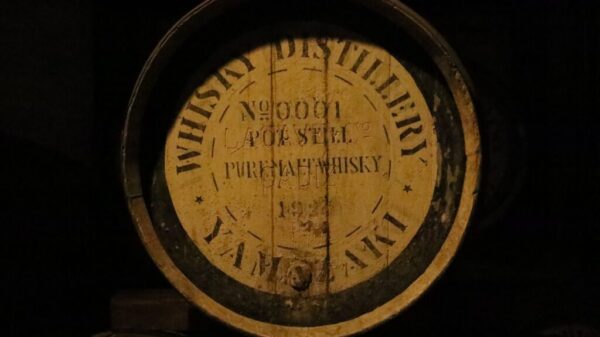


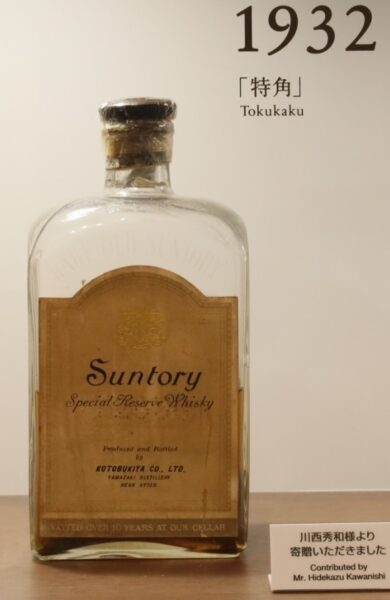
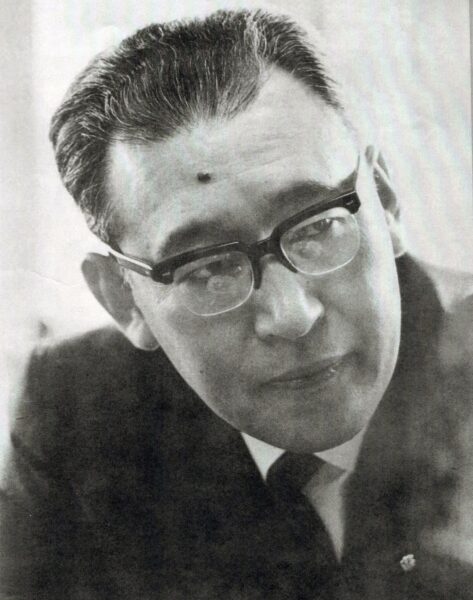
.png)
